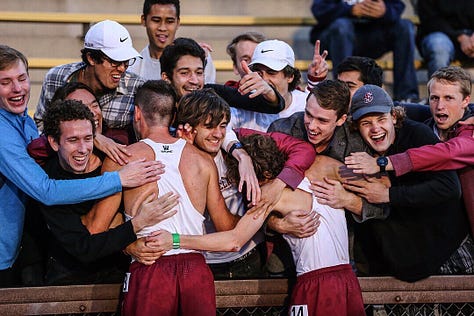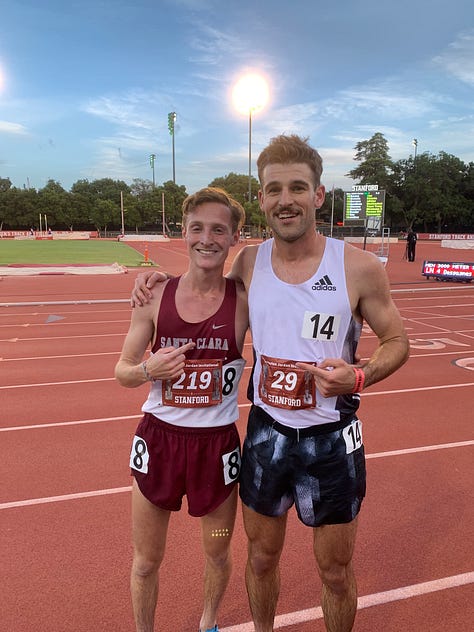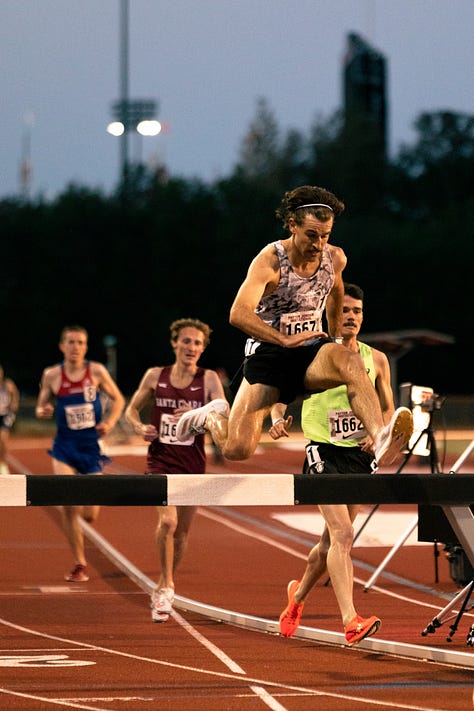Payton Jordan
In spring 2014, my college teammates and I made the quick trip up from Santa Clara to Stanford University to watch the Payton Jordan Invitational. After a couple years of going to Stanford meets, either as participants or as spectators, we started noticing that the athletes at every single one of these meets wore a red wristband to access the “athlete” area– for the track meet, that’s on the backstretch of the track, where there’s no grandstands or general admission spectators.
With this discovered intel, we devised a plan.
Racing the Stanford Cross Country Invite that previous fall, we made sure to save our athlete wristbands following the races. We found our in.
Come May 4th, 2014. About six of us dressed in running warmups, taped on our old red wristbands, and jogged through the security guarded gates into the athlete area, flashing our “official” athlete wristband. Security waved us right through.
We’re in.
Being 19 years old at the time and still relatively new to track, I didn’t recognize too many of the pros other than the few American protagonists. I realized this naivety years later; if you watch old race videos, you can see us standing next to Jakob Ingebritsen along the backstretch during the 5000 meter race, watching his brother Henrik race. I had no idea.
The highlight of that night, however, had to be the men’s 5000 meters. It was a race for the ages– Ben True and Hassan Mead went to blows in the last 100 meters, with True breaking the tape in a world lead and an unprecedented (at that time) 13:02 result. Following the historic finish, Ben waves to the crowd, entertains an interview with FloTrack, and jogs back to the athlete area– right along the fence I’m standing behind with my teammates. As he jogs by, I put out my hand for a fist bump. Backed by what I could only imagine was pure adrenaline, Ben punched my fist as hard as he could. Or at least that’s what it felt like. My hand hurt for a week.
It was awesome, I’ll never forget it. I envisioned myself racing there one day.
2025
Present day, I’ve now raced at the Payton Jordan Invitational five times; most recently this past weekend. Over the years, the meet has lost some of its aura– what used to be a proving ground for pro runners, looking to nail their outdoor standards for the year in beautiful conditions, has become a normal college invitational. The excitement of being a part of a great tradition of fast running has turned into a meet where a pro can start their steeplechase season in the shadows, so to speak. Growing up 20 minutes north of Stanford, it’s a great opportunity to visit my family and friends back home. Free lodging and meals from Mom and Dad helps, too.



Why race under the shadows? Historically speaking, my first steeplechase race of the season is a little rough. Physically, mentally, spiritually– it’s not fun, and it shows in the results. This year, it really showed. Coming off of a busy road racing season, it wasn’t hard to believe that the transition to the track was going to feel like a kick to the gut. Adding barriers and a water jump into the equation, and I was in for a rough one. Finishing in 8:42 for 4th, it was my worst opener since 2021– my PB at that time was 8:44. I felt like a baby giraffe out there, and the result is a little embarrassing.
A lot of runners have a bad race like this and want to hide. They latch the result to their fitness or abilities at that time, and it can set a poor tone for the rest of the season.
Not me though– consider me completely unfazed from the poor performance. I’ve given up on the need to knock every single race out of the park, and it’s important to explain why:
Ask any pro athlete what they’re focused on through a season, and it’s one thing: win a championship. Many athletes and coaches will operate on a working backwards formula. The first question they ask:
“What’s the ultimate goal?”
Answer that question, and then work backwards to establish and check the necessary boxes in working towards that goal.
To put it in non-running terms, nobody really cares about the results of spring training in the MLB– it’s all about getting in the reps and ruffling out the silly mistakes in performance and judgement. If you can put together a productive spring training, you go into the season prepared to work on the things that help make your team a deep playoff contender. There’s a lot to learn from the early season games, and it helps you be better prepared for addressing strengths and weaknesses throughout the year.
Payton Jordan was my spring training. Four months before USA outdoor champs, I put Payton Jordan on the schedule knowing it would be a suffer fest, but it would help me perform when it matters. It was a necessary evil in working backwards to my ultimate goal for 2025.
Now, The Good Stuff
The rest of this write-up is going to be about as in-depth as possible with my mindset going into the 2025 steeplechase season. As fans (yes, I also consider myself as a fan of the sport) we rarely hear why athletes set their schedule or training focuses for a season, outside of using buzz phrases like “tuning up,” and “practicing speed/ strength” in off distance races. This will be a look into a more personal, athlete development strategy.
*Important to note: I feel comfortable writing this because my overall racing mantra is doing my best– control what I can control, and make real-time adjustments based on what’s best for me in training and racing. I think of racing like a chess match– my opponent makes a move, and I in turn make adjustments to my strategy for the most optimal result.
Lastly, I’ll mention a name or two of my competitors– it should be obvious that they’re mentioned from a place of respect for their talent and abilities.
Working Backwards
Let’s start with the ultimate goal. This year, my biggest goal is:
Qualify for the 2025 World Athletics World Track & Field Championships in Tokyo, Japan.
Big goal, I know. How do we get there?
Without a doubt, I need to place in the top three in the USA Championship final. The event is competitive enough in the US where the top three will already have the standard (8:15.00) or enough ranking points to qualify. We saw this at the Olympic Trials last year, where only one of the top three qualifiers achieved the standard before Paris.
Great. How do I place top three?
This is a loaded question, and this provides the meat of my working backwards method, because execution on race day is so important.
Based on last year, I suspect there are around 10 guys in the US that believe they have a legitimate shot of qualifying for Tokyo. Some are more realistic than others– I think, on paper, I lean more towards the unrealistic side than realistic, based on past performances. Kenneth Rooks takes the cake for the most realistic: he is the reigning Olympic silver medalist from Paris, and has the best recent performance in the USA by seven seconds, 8:06. Rooks has a foolproof tactic that won him Olympic silver: he can hammer the last 800 meters, typically closing around 2 minutes flat. Nobody in the country has been able to replicate this ability as of recent, and it puts him as the clear protagonist in this year’s USA final. It reminds me of Evan Jager, who could easily close in sub 2:00 for the last two laps in his prime– nobody in the US stood a chance against him. We’ll see how people step up this year.
Now I don’t have to beat Kenneth to qualify for worlds, as top three qualify. But, as we see time and time again, the field usually plays to the best runner’s strengths. It’s a little crazy, but it’s a ticket to a medal at a big championship or a qualifier for the global championship. It’s funny to watch old race videos of Mo Farah, where the field jogs the first 85% of a race, waiting to shadow Mo in an all out sprint on the last lap. Most of the time they deferred the win, but the best of the rest have a medal for their efforts.
I believe there will be a similar dynamic in the US final this year: everyone will prepare this season to be as fast as possible over the last two laps. The best three men over the final 800 meters will punch their ticket to Tokyo.
Not saying the final will be a jog fest– there’s great reason to believe there are one or two guys that will want to run 8:10 pace from the gun to make it harder to close. That guy won’t be me. That’s not my ticket to the show. But it’s important to be ready for anything.
Given this mentality, with my working backwards method, developing better speed endurance over the last couple of laps is crucial. My fastest close has been 62 seconds from last year’s Olympic Trials final, with the last 800 being around 2:07. From the Trials, USATF has every 100 meter split from the race, and there are some glaring inhibitors to my speed over the final kilometer of the race. If I want to get top three, here are the things that need work:
Second to last lap: I struggle to commit. Everyone in the final ran a 62 or 63 second penultimate lap, while I split a 64.58, the slowest of the top nine finishers. Committing early is key, because 900 meters to go was when Rooks made his drive for home last year.
The water pit: it may look smooth, but I lose time over the water jump, even more so with a faster pace. While the fastest men over the last lap propel themselves off the barrier, keeping their chest forward and staying low, my chest stays upright, and “pop up” off the barrier– my momentum goes more up than forward when pushing off into the water pit, losing precious time and forward movement out of the pit. The extra height off the top of the barrier also creates more fatigue in already tired legs. The 100 meter splits reflect this.
The key now is implementing these tweaks into practice– practice also includes racing, but ideally you can dial the technique in training to work on race execution. For me, my primary focus in practice is efficient hurdling and water jumps. As I said: stay low, chest forward (but not hunched over) and carry your momentum through the barriers. On the water jump, push through, not out. While replicating this in practice, supplementary exercises and stretches are done in the gym to create the form I need to navigate the barriers: strong hip flexors, loose TFLs and glute medius, good pop in the legs to push off the water jump barrier. There needs to be some explosiveness training in the weight room, and the mobility to move without a hitch.
Each race now serves as a platform to put these skills to practice. Part of working backwards is identifying what the goal of each race is going to be. It’s not always to win, but to get a little better at what you’re looking for.
It’s really difficult to put a season together, and my April plan proved to be too busy to put in the necessary training to be ready for a good season opener at Stanford. However, knocking Stanford out of the park wasn’t the goal. The goal was to get some “in-game” reps in, and start getting the feel for racing over barriers again. Given my openers are hit or miss, opening my steeple season at a key steeple is not the move. It wasn’t fun, but a necessary evil. It also turned out to be a great way to light a fire under my ass– I’m more motivated in being prepared.
The next steeple is Sound Running Track Fest on May 24. Since USATF canceled the gold labeled LA Grand Prix, many steeplers will now be racing at Sound, given it has the a silver label. With the anticipated field of racers, winning might be slightly out of my wheelhouse right now. Without the goal being solely to win, there are small goals that I can still check off in preparation for USAs:
Focus on competing. Beat as many people as possible. Success in a heavily domestic field can bring confidence leading into a national championship.
Work up through the field. Sometimes, I put myself at the front too early in the race. I operate a lot better while progressing through the field, rather than be up front and losing places. Ideally, this can put me near the front with a lap to go, and anything can happen from there.
CLOSE HARD. In the past, it hasn’t been hard for me to be discouraged if it feels like I’m losing ground. To combat this, it’s important to manage my effort throughout the race to close fast, and reel in at least one competitor in the last 300 meters. A small goal, but it will be a step in the right direction.
Following Sound Running, the plan will most likely be traveling to Europe for two steeple races; which two I’m waiting to hear back on. If everything at Sound goes according to plan, these next races will be less about patience and more about throwing myself into the lion’s den. As already mentioned, I’m anticipating USAs to be hot from the gun, and I need to throw myself into fast paces early in the race, so it won’t feel like a total shock in the final. These races are slated for ~8:10 pace from what I’ve heard. These will be two great opportunities to put it all out there and see where I end up.
From there, it’s all about putting in a good six week block of training heading into USAs. This training block will be focused on being as good of a 5k runner as possible– a focus derived from Jager, who was a 13:02 5k runner alongside his 8:00 American record steeple PB. There might be a 1500 or mile race thrown in there to spice things up, but all the focus is on the steeple. Every steeple session will have my aforementioned process goals in mind, and everything else will be focused on getting in the right shape to execute in between the barriers. With two teammates training for the 5k that have run around 13:10, there’s no lack of training partners to push me when needed. I’m tempted to tell my coach, Joan Hunter, to put out a hurdle or two during our 5k workouts and force me to find a way to keep up, just for fun (Joan– if you’re reading this, I’m kidding, don't actually do this).
Concluding
Every year I keep getting better and better at the steeple. Since being under Joan’s coaching, I’ve dropped my PB from 8:44 at the beginning of 2021 to 8:20 in 2024. With LA 2028 in mind, that trajectory puts me in a dangerous position. I’m eyeing sub 8:10 by that time– no doubt a lot of my competitors are thinking the same for themselves. That’s why it’s extra crucial to focus on my race execution, rather than just being as fast as possible.
As always, I appreciate your time and support, and look forward to seeing the game plan through this season, now with you all following along with this intel in real time. Feel free to contribute in the comments or by reaching out to me personally.
Cheers team,
Joey







8:09:56 inbound, I had a vision
Love all of this man!
We'll be screaming for ya